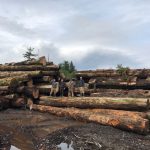

Alaska Specialty Woods is known for sourcing the finest Sitka Spruce tonewoods for soundboards available through sustainable forestry and responsible wood use.
What happens when Sitka Spruce trees freeze, though? Temperatures in Alaska have been quite cold these past few weeks, and an area tree surgeon named Dennis Symmons had an interesting tale to tell on the KTOO website (http://www.ktoo.org/2016/12/11/frozen-spruce-make-extra-danger-woodcutting/).
Symmons was reminded that frozen Sitka Spruce are not easy to deal with, even for professionals. He described the trees as “not trees anymore,” considering them more like giant “sticks of celery” or “a sweaty stick of dynamite.” When trying to top or fell a tree in freezing conditions, it can be dangerous.
Symmons remembered a job he did on a Sitka Spruce several years ago. It was a 90-footer that he just walked up. At about 14-feet off the ground, he took his chainsaw and started cutting on a frozen top. He thought he was fine until the whole thing exploded on him. “It launched me upside down, into the air, feet-first,” he recalled.
Suffice it to say that cutting Sitka Spruce in the cold wintertime can be a challenge.
“The outside couple of inches have the most moisture and freeze the hardest,” said Symmons. It can take a sharp saw blade and make it feel really dull.
Alaska Specialty Woods tries to find wind blown trees to use for its purposes, rather than wasting precious resources through clear-cut logging. The company looks for logs that are three to eight feet in diameter. Furthermore, is there “music” in the wood? If it passes some tests, it’s chosen. Only a small percentage of any large diameter log makes tonewood grade.
Overall, the main objective of Alaska Specialty Woods is to supply Luthiers, manufacturers and builders of acoustic instruments with the highest quality sound board material there is on the planet!
All of the soundboards found on AlaskaWoods.com are sustainably harvested from old-growth timber, we call them EarthTone Soundboards™. Learn more about what makes EarthTone Soundboards™ the finest in the world.
Copyright © 2023 Alaska Woods • 855-425-9663